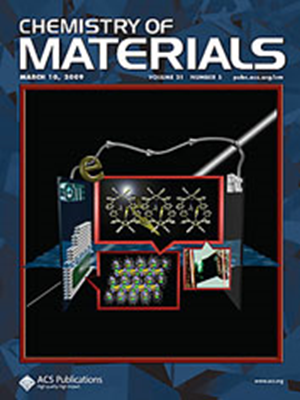用于电子安全指示器的多态电致变色共价有机框架薄膜
IF 7
2区 材料科学
Q2 CHEMISTRY, PHYSICAL
引用次数: 0
摘要
巧妙地设计具有可调氧化还原功能的共轭有机框架,可以在最小的工作电压下实现多态颜色切换,这对于低能耗光电子学来说是非常理想的。在此,我们开发了一种二维电致变色共价有机框架(EC-COF)薄膜,在外加电位下,该薄膜在紫外-可见光-近红外(NIR)范围内具有广泛的吸收。在铟锡氧化物涂层玻璃基底上生长的 EC-COF 薄膜显示出三态阳极电致变色,在近红外区域的色彩对比度高达 60%。EC-COF 薄膜具有可逆的颜色变化,着色效率高,切换响应快(着色时间:4.9 秒;在 1100 纳米波长下漂白时间:10.6 秒)。EC-COF 的高多孔性有利于离子通过一维孔道运动。为了展示电化学特性的实时应用,我们首次开发了一种采用 EC-COF 薄膜作为电子电路安全指示器的原型装置。该装置与定制的手机应用相结合,在一定电位范围内通过微妙的颜色变化监测电子传感器系统的安全性,精确度接近 98%。目前的研究为先进节能显示设备中多色电致变色多孔有机材料的功能性开发提供了一条新途径。本文章由计算机程序翻译,如有差异,请以英文原文为准。

Multistate Electrochromic Covalent Organic Framework Film for Electronic Safety Indicator
The smart design of a conjugated organic framework with tunable redox functionalities could lead to multistate color switching under minimal operating voltage, which is desirable for low-energy-consuming optoelectronics. Herein, we have developed a two-dimensional electrochromic covalent organic framework (EC-COF) film exhibiting broad absorption across the ultraviolet–visible–near-infrared (NIR) range under applied potentials. The EC-COF films grown on an indium tin oxide-coated glass substrate show three-state anodic electrochromism with a high color contrast of ∼60% in the NIR region. The EC-COF film shows reversible color changes with high coloration efficiency and fast switching response (coloration time: 4.9 s; bleaching time: 10.6 s at 1100 nm). The highly porous nature of EC-COF facilitates ion movement through 1D pore channels. Demonstrating the real-time application of electrochemical attributes, we have developed, for the first time, a prototype device employing an EC-COF film as a safety indicator for electronic circuits. The device, coupled with a customized cellphone application, has been demonstrated for monitoring the safety of electronic sensor systems through subtle color variation under a range of potentials with a close-to-perfect accuracy of ∼98%. The current study provides a new avenue for the function-led development of multicolored electrochromic porous organic materials in advanced energy-efficient display devices.
求助全文
通过发布文献求助,成功后即可免费获取论文全文。
去求助
来源期刊

Chemistry of Materials
工程技术-材料科学:综合
CiteScore
14.10
自引率
5.80%
发文量
929
审稿时长
1.5 months
期刊介绍:
The journal Chemistry of Materials focuses on publishing original research at the intersection of materials science and chemistry. The studies published in the journal involve chemistry as a prominent component and explore topics such as the design, synthesis, characterization, processing, understanding, and application of functional or potentially functional materials. The journal covers various areas of interest, including inorganic and organic solid-state chemistry, nanomaterials, biomaterials, thin films and polymers, and composite/hybrid materials. The journal particularly seeks papers that highlight the creation or development of innovative materials with novel optical, electrical, magnetic, catalytic, or mechanical properties. It is essential that manuscripts on these topics have a primary focus on the chemistry of materials and represent a significant advancement compared to prior research. Before external reviews are sought, submitted manuscripts undergo a review process by a minimum of two editors to ensure their appropriateness for the journal and the presence of sufficient evidence of a significant advance that will be of broad interest to the materials chemistry community.
 求助内容:
求助内容: 应助结果提醒方式:
应助结果提醒方式:


